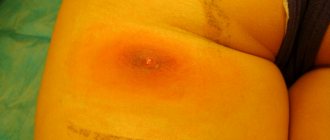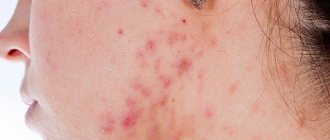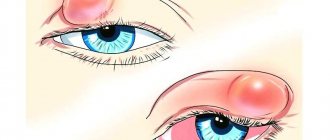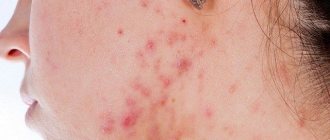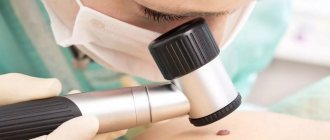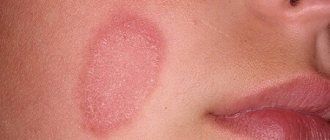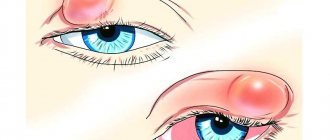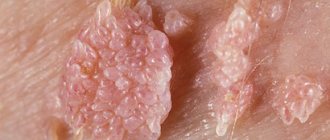A furuncle is an acute purulent inflammation of the hair follicle, sebaceous gland and the surrounding subcutaneous tissue.
It can develop on any part of the body that has hair, with the exception of the palms and soles, where there are no hair follicles. The predominant localization is the face, back of the head, groin areas, buttocks, dorsum of the forearms and hands. The most common pathogen is staphylococcus. The development of the disease is facilitated by constant contamination and friction of the skin on clothing, abrasions, scratching, as well as increased activity of the sweat and sebaceous glands in certain diseases (seborrhea, acne, etc.), decreased immunity of the body, and hypovitaminosis. Most often, boils occur during puberty in adolescents, as well as with endocrine disorders (diabetes mellitus, etc.).
Carbuncle
A carbuncle is several boils connected to each other by numerous passages. The infection usually develops due to the ingestion of Staphylococcus aureus and can lead to significant skin necrosis. During treatment, the patient is prescribed antibiotics, and sometimes surgery is required.
Causes of carbuncle
The appearance of a carbuncle is preceded by an inflammatory process in the soft tissues, which usually begins with an inflammatory disease of the hair follicle - staphylococcal folliculitis, less often - with streptococcal folliculitis.
The development of inflammation can lead to the formation of a boil, which is an acute purulent-necrotic inflammation of the hair follicle. When several such boils form in one area of the body, they can merge with each other.
The product of the merger of several boils is a carbuncle. A sharp bursting pain occurs in the area of infiltration. The skin over the infiltrate becomes purple, tense, and swollen. Large amounts of gray-green pus are released from the pustules.
The tissues become necrotic. There are clear signs of general intoxication: tachycardia, nausea, vomiting, severe headache, hyperthermia up to 39-40 ° C, leukocytosis, shift of the blood count to the left, lack of appetite, insomnia. If the carbuncle is localized on the face, the symptoms of intoxication are much more pronounced, even to the point of fainting.
After exfoliation of necrotic tissue and removal of pus, the severity of signs of intoxication weakens significantly.
Risk factors for carbuncle formation:
- the presence of a chronic source of infection in the body;
- lack of vitamins;
- diabetes mellitus and other metabolic disorders;
- exhaustion of the body;
- psychological overload;
- immunodeficiency states;
- recent operations or serious illnesses;
- skin contamination, poor sanitary culture;
- nutritional deficiency;
- obesity;
- prolonged friction of the skin with clothing;
- increased sweating.
Carbuncle mainly affects teenagers and young adults. Men get sick more often than women.
Symptoms of a boil
- The disease begins with a slight tingling sensation, changes in sensitivity (numbness) of a certain area of the skin, chills and a slight increase in body temperature.
- Pain, swelling and redness of the skin appear with the formation of a dense nodule with a diameter of up to 2 cm.
- Then, in the center of this nodule, corresponding to the exit of the hair, a so-called rod (a section of dead tissue) appears, which is gradually torn away, after which the wounded defect is cleared of pus and heals with the formation of a scar.
- With a boil in the area of the upper lip, nose, nasolabial folds and bridge of the nose, there is a high risk of infection spreading with the development of purulent meningitis and sepsis. Over the course of 1–2 days, an inflammatory infiltrate forms. A facial boil is accompanied by severe swelling, although the pain may be minor.
Symptoms of carbuncle
Clinical signs of a carbuncle are:
- suppuration and wound formation;
- hyperemia of the skin around the lesion;
- severe pain in the entire affected area.
The appearance and development of a carbuncle is usually accompanied by the following symptoms:
- elevated temperature, which often reaches 40 degrees;
- major intoxication;
- vomiting;
- nausea;
- loss of appetite;
- headache;
- general malaise.
These signs are especially pronounced when the carbuncle appears on the face or neck.
There are 3 stages of carbuncle:
Stage 1: infiltrate (folliculitis)
During this period, nodes form under the skin, which will be represented by inflamed hair follicles. The infiltrate contains adipose tissue, pus, lymph and lymphocytes. Nodules rise above the surface of the skin.
Since the nutrition of the dermis is disrupted, it acquires a bluish color. After a few days (from 9 to 12), the infiltrate reaches impressive sizes. It can be about 10 cm in diameter. The skin is swollen, tense, and hot to the touch. The more swelling there is, the more intense the pain will be.
Stage 2: purulent formation
At the stage of suppuration, the carbuncle reaches maturity. Blisters form on it, which are filled with pus. They open, so the surface of the carbuncle resembles a sieve. Through these small holes, pus leaks out, mixed with blood and dead epithelium.
The suppuration stage lasts about 14-21 days. During this period, the patient’s general health deteriorates.
Stage 3: necrosis and tissue rejection
During this period, pus from the carbuncle stops oozing. At the site of inflammation, ulcers are formed that will have rods. They merge with each other, forming one large defect. Tissue damage is very intense and often involves muscles. The affected area is black.
The wound heals slowly, gradually filling with granulations. A scar remains in its place. The necrosis stage lasts about 21 days.
1.General information
Carbuncle is one of the common types of infectious and inflammatory skin lesions. The name comes from the ancient Greek "carbon" (coal) and is based on an association with a smoldering coal, which can be caused by the appearance of a blackened focus of purulent-necrotic tissue decay in combination with inflammatory hyperemia, and sometimes bleeding.
The carbuncle differs from clinically similar ulcers in the tendency for the inflammatory process to quickly spread to several hair follicles simultaneously, which creates the precondition for further expansion, and under unfavorable conditions (for example, against the background of diabetes mellitus or weakened immunity) it can result in sepsis, meningitis, phlegmon and other life-threatening diseases. states.
Carbuncles occur in all age categories, but there is a statistical predominance of young people (which is explained by the characteristics of hormonal activity and secretory function of the sebaceous glands), and the male gender predominates.
A must read! Help with treatment and hospitalization!
Methods for diagnosing carbuncle
Carbuncle is diagnosed based on clinical symptoms.
Differential diagnosis is carried out with the following pathologies:
- rupture of an epidermal cyst;
- hidradenitis (if the carbuncle is localized in the perineum or armpit);
- anthrax;
- chronic ulcerative herpes.
Laboratory diagnostics
Microscopy of the smear reveals staphylococci. Bacterial culture allows identification of the pathogen and assessment of sensitivity to antibiotics.
Sign up for diagnostics To accurately diagnose the disease, make an appointment with specialists from the Family Doctor network.
2. Reasons
Carbuncle is a typical focal staphylococcal infection. The pathogen is usually Staphylococcus aureus, less often other types of staphylococcus; Even more rarely, streptococcus or a polymicrobial infection is cultured, where staphylococci are again present, and only in isolated cases are other bacterial pathogens found.
Risk factors include hyperfunction of the sebaceous glands, the presence of microtraumas, cracks and abrasions on the skin, prolonged physical activity in polluted areas or in dusty air, as well as the presence of underlying diseases with metabolic disorders and/or a decrease in general resistance and local immunity.
Visit our Dermatology page
Treatment methods for carbuncle
Small carbuncles that occur without noticeable intoxication and deterioration of the patient’s general condition are treated on an outpatient basis.
In cases where
- the patient is severely intoxicated,
- the carbuncle is large and localized on the face,
- the patient suffers from uncompensated diabetes mellitus or other serious diseases,
treatment is carried out in a hospital.
Conservative treatment
If treatment of the carbuncle was started at the stage of its maturation, then conservative methods are used, which in most cases leads to regression of the disease, that is, resorption of the infiltrate.
Antibacterial drugs with a broad spectrum of action are indicated for oral administration to the patient.
At the same time, the carbuncle itself is injected with antibiotics. To reduce pain, analgesics (Novocaine, Lidocaine) are used.
The surface of the carbuncle is treated with ethyl alcohol or other alcohol-containing antiseptics. An aseptic dressing is applied. Syntomycin or streptomycin emulsions are also used.
Surgery
If the carbuncle enters the necrotic stage, then this is an indication for surgery, which is performed while using antibiotic therapy.
The operation consists of dissecting the carbuncle and removing necrotic tissue from it.
Then a tampon with a hypertonic sodium chloride solution and proteolytic enzymes is inserted into the wound.
To clean the postoperative wound and completely remove necrotic tissue, the dressing is changed daily.
Physiotherapy
At the maturation stage, as well as in the postoperative period, UHF therapy and local ultraviolet radiation are prescribed.
To stimulate the body's defenses, intravenous laser and ultraviolet irradiation of blood can also be performed.
More information about the treatment method
Make an appointment Do not self-medicate. Contact our specialists who will correctly diagnose and prescribe treatment.
Rate how useful the material was
thank you for rating
Treatment of a boil
In most cases, treatment is carried out at home (outpatient), but in severe cases of the disease, especially with facial boils, hospitalization in the surgical department may be necessary.
In the edematous stage of the disease, until purulent melting of the tissues, bandages with antiseptic solutions are used, and physiotherapeutic procedures are used if indicated. It is undesirable to use any ointments, as they promote suppuration.
If suppuration develops, the basis of treatment is timely and adequate surgical intervention, daily dressings under the supervision of a physician. Antibiotics are prescribed according to indications.
Facial boils threaten the spread of infection to the cerebral sinuses with the development of purulent meningitis and sepsis. Therefore, all manipulations with boils in this area should be strictly limited; Early prescription of antibiotics is indicated, preferably in a hospital setting. It is necessary to limit talking and chewing, and bed rest.
Surgical methods for treating boils
Usually, the boil is opened and the necrotic core is removed under local or general anesthesia. If the abscess is superficial and there is no significant swelling of the surrounding tissues, it is only possible to remove the necrotic core without an incision. Recovery usually occurs quickly after this minimal intervention.
Felon
Panaritium is an acute purulent inflammation of the tissues of the finger. Develops on the nail phalanx of the finger, less often on the foot, due to bacterial infection in small wounds (splinters, cracks, scratches, cuts, injections, etc.). Based on the nature of inflammation, serous (edematous) and purulent stages of panaritium are distinguished. There are superficial (cutaneous, periungual) and deep (subcutaneous, tendon, articular, bone) forms of purulent inflammation of the fingers.
Symptoms characteristic of panaritium
Microtrauma preceding inflammation, swelling and redness at the site of injury. Pain in the finger, aggravated by movement, touching, or lowering the hand.
Surface forms of felon
With cutaneous felon, pus accumulates under the outer layer of skin to form a blister filled with cloudy, sometimes bloody fluid; the skin around the bubble turns red.
The pain is usually moderate, the temperature is normal.
Periungual panaritium (paronychia) is manifested by inflammation of the cushion surrounding the base of the nail, which swells, turns red, and becomes painful. When pressed, pus comes out from under it.
Deep forms of felon
Typically, inflammation occurs first under the skin. Since the skin on the palmar side of the finger is dense, the pus that forms under it cannot break out for a long time, and the process spreads deep into the tendon, joint, bone, sometimes affecting them simultaneously.
The pain is very severe, accompanied by limited finger mobility and increased temperature.
The pulsating nature of the pain and its intensification at night indicate the development of the purulent stage of panaritium and require emergency surgery.
Any form of panaritium can lead to severe complications that cause long-term disability and even disability. Complications usually develop as a result of self-medication and late seeking medical help.
The most dangerous complications of panaritium
- in the early stages, the spread of infection to the entire finger (pandactylitis), hand and forearm with the development of phlegmon, sepsis,
- in the later stages - disfigurement of the nail phalanx, contracture of the finger.
Examination for panaritium
A general medical examination is of primary importance. If there is a suspicion of bone or articular panaritium, as well as with a long course of the disease, an x-ray examination is necessary.
Treatment of felon
To prevent panaritium, in case of any, even minor damage to the finger, you should treat the wound with antiseptics and apply a bandage. If there is a foreign body (splinter), it must be removed immediately.
If felon does develop, in the first 2 days of the disease, before suppuration develops, doctors prescribe conservative treatment. It is acceptable to use antiseptics, semi-alcoholic wet-dry dressings, and antibiotics. Warming compresses and ointments are contraindicated.
If this treatment is ineffective, surgical treatment is indicated - opening and draining the abscess. Further treatment consists of regular daily dressings, the use of antibiotics, and physiotherapeutic treatment.
If you need to make an appointment with a surgeon, you can do this directly on our website - by sending a request or by calling.
Types of carbuncles and their symptoms
Depending on which particular flora caused the formation of the carbuncle, the following types of suppuration are distinguished:
- Emphysematous. The disease has an acute course. Only cattle suffer from such carbuncles. People do not become infected with this type of carbunculosis.
- Purulent. This type of carbuncles is diagnosed more often than others.
- Anthrax. The symptoms of this disorder are very specific. Such carbuncles can occur in both humans and animals (domestic and wild).
- Plague. Pathology is rarely detected. The causative agent is the plague bacillus.
Emphysematous carbuncle
This disease is caused by bacterial flora from the class of clostridia, namely Clostridium chauvoei. Artiodactyl animals most often suffer from emphysematous carbuncles; in humans, the disease is practically not diagnosed. When cattle are affected, tumors are palpated in their muscles and produce a specific crunching sound.
Most often the disease is found in young animals. In most cases, carbuncles lead to the death of individuals. The peak incidence occurs in summer and autumn.
Purulent carbuncle
Most often, people have a purulent carbuncle caused by Staphylococcus aureus. Other pathogenic flora cause inflammation less frequently. A person experiences suppuration of the epidermis and fiber that surrounds the sebaceous glands and hair follicles. Single carbuncles tend to merge into large foci, forming an infiltrate.
This type of disease often requires the help of a surgeon, as it threatens the development of serious complications.
Anthrax carbuncle
Anthrax carbuncle looks like a small red pimple that itches all the time. After just 2 days, a pustule forms at the site of the lesion. It looks like a bubble containing a reddish liquid inside. Taking the contents from the pustule for bacterial culture allows you to identify anthrax bacilli.
After some time, the bubble opens and a crust forms on its surface. The scab quickly darkens. After a few hours, the crust becomes hard and completely black, with new small bubbles appearing around it. These bubbles also contain liquid inside. The tissue surrounding the carbuncle swells and then dies.
Inflammation develops under the influence of toxins released by bacteria. They provoke disruption of tissue nutrition. Swelling increases in the affected area, and then necrosis occurs.
Symptoms of anthrax infection:
- Pain in the affected area is barely noticeable or absent at all.
- After opening the papule, a scab begins to form instead.
- New blisters appear around the scab.
- There is no pus in the affected area.
- The area of inflammation loses its former sensitivity, the skin in this area becomes numb.
Plague Carbuncle
A plague carbuncle forms in the area of the body that was affected by the plague pathogen.
Symptoms of the disease:
- Intense pain.
- Significant swelling.
- Suppuration. There will be a lot of pus in the affected area.
- Tissue necrosis.
Which doctor treats carbuncle?
When the first signs of a carbuncle appear, you should visit a dermatologist. If it is not possible to cope with the inflammation, then the help of a surgeon is required.
When carbuncles occur regularly in a patient, consultation with an immunologist is required. To cope with the disease, you need to find out the causes of its occurrence. In addition to the specialists listed, the patient may need to consult an endocrinologist, oncologist, hematologist, etc.
Depending on where exactly the carbuncle forms, you need to choose a specialist. If it is located next to the ear, then the help of an otolaryngologist is required. When the carbuncle is concentrated in the groin, the woman should visit a gynecologist.
Complications and consequences
Pus is constantly forming in the cavity of the carbuncle. The larger the abscess, the more intense the inflammatory process will be. The infection affects deep tissues and can penetrate the blood and lymphatic tract.
If a person’s immunity is weakened by chronic diseases, then a carbuncle can lead to complications such as:
- Thrombophlebitis.
- Erysipelas.
- Damage to the integrity of blood vessels and the development of bleeding.
- Osteomyelitis
- Abscess.
- Inflammation of the brain.
- Phlebitis.
If a person develops sepsis, the likelihood of death increases.
First aid
The sooner treatment is started, the better the prognosis. In this case, it will be possible to get rid of the carbuncle without the help of a surgeon. Therapy will be limited to antibacterial therapy and anti-inflammatory drugs.
Provided that a person’s well-being sharply deteriorates and the carbuncle quickly necrotizes, the patient is referred for surgery. It is mandatory to surgically remove the carbuncle, which is caused by anthrax.
If immediately after the appearance of an abscess a person receives quality help, then complications of the carbuncle will not develop.
Basic treatment recommendations:
- Wipe the affected area with alcohol.
- Apply a bandage with Vishnevsky ointment to the carbuncle.
- Contact a surgeon.
Furuncles and carbuncles often develop on the face. Boils are common, and carbuncles are less common. The prolonged course of boils and the progression of inflammatory phenomena can lead to the development of a carbuncle.If the symptoms of the disease progress rapidly and your health deteriorates sharply, you need to call an ambulance.
Etiology. The causative agents are streptococci and staphylococci, including Staphylococcus aureus and Staphylococcus aureus.
Pathogenesis. The infection usually penetrates from the skin through the duct of the sebaceous gland or along the hair shaft into the subcutaneous base of the skin. A purulent follicular pustule forms in the pilosebaceous sac, followed by involvement of the dermis and surrounding tissue in the process. A boil often appears against the background of certain skin diseases. With pyoderma, sycosis, eczema, purulent acne, sensitization of the body is created, against the background of which a boil or carbuncle develops. Furuncles and carbuncles often occur in a number of common diseases, such as diabetes.
Pathological anatomy. With a boil, purulent inflammation occurs in the hair follicle, sebaceous gland and adjacent connective tissue. At the mouth of the follicle, a pustule is formed from neutrophilic leukocytes, which is surrounded by accumulations of microorganisms and their decay products. Further, inflammatory phenomena spread along the hair follicle to the papillary bodies and adjacent areas of connective tissue. In the center of the lesion, necrotic processes develop with the formation of a rod spreading to the epidermis. Breaking through it, the rod comes out, and the remaining cavity is filled with granulations, which, when mature, form a scar.
With carbuncle, such inflammatory changes appear in several hair follicles and sebaceous glands. Diffuse inflammation and extensive necrosis develop. In the circle of the affected tissues, purulent inflammation of the adjacent tissue and muscles adjacent to it occurs. Often veins are involved in the inflammatory process, the infection spreads along the vessel with the formation of phlebitis or thrombophlebitis. After the necrotic areas are rejected, the skin is perforated in many places and then the cavities are filled with granulation tissue and scarred.
Furuncle is a purulent-necrotic inflammation of the hair follicle (or follicles), sebaceous glands and surrounding connective tissue.
Clinical picture. Boils on the face are most often localized in the area of the upper or lower lip, less often on the nose, cheek, chin, forehead. With the development of a boil on the face, the general condition may be satisfactory; sometimes body temperature rises to 37.5-38 oC, chills. An area of reddened skin forms, on which a papule often appears. The pain in the affected tissues intensifies, they become denser, forming a painful, usually round infiltrate, covered with red or purplish-blue skin. The papule located in the center is filled with serous or purulent fluid. Subsequently, it empties and under it the area of necrosis - the rod - is torn off and pus is released. After the lesion is emptied, the inflammatory phenomena subside, and the infiltrate slowly resolves.
Complications. Boils on the face, located near and along the facial vein, can be complicated by phlebitis or thrombophlebitis.
Carbuncle is an acute purulent-necrotic inflammation of several hair follicles and sebaceous glands with the formation of extensive necrosis of the skin and subcutaneous fat. Often, a carbuncle develops from a boil when it is not emptied and neighboring hair follicles and sebaceous glands are involved in the process.
Clinical picture. The course is moderate or severe, accompanied by an increase in body temperature above 38 ° C, chills, headache, loss of appetite, nausea, vomiting, insomnia, and sometimes delirium. In some patients, the disease occurs against the background of a satisfactory condition with moderate symptoms of intoxication. Patients complain of sharp pain at the site of the lesion, often spreading along the branches of the trigeminal nerve.
On external examination, the infiltrate is diffuse, painful, covered with bright red skin, adherent to the underlying tissues. Infiltration spreads to adjacent tissues, swelling in the surrounding tissues is significant. According to the location of the carbuncle, swelling and swelling of the adjacent tissues are located: when a carbuncle occurs on the upper lip, swelling of the buccal, infraorbital areas, wing and base of the nose; with carbuncle of the chin - buccal, submandibular and chin areas. With these localizations, the anterior facial vein is often involved in the process. In such cases, swelling and infiltration appear along its course to the inner corner of the eye. Regional lymph nodes on the affected side are painful, enlarged, and often fused into packets. Gradually, the infiltrate thickens in the center, the epidermis breaks through in several places. Thick pus is released from areas of skin perforation, and necrotic tissue is gradually rejected. This leads to subsidence of inflammatory phenomena, limitation of infiltration, reduction of swelling of surrounding tissues, cleansing of wounds and filling of cavities with granulations.
Complications. Facial carbuncle can be complicated by phlebitis, thrombophlebitis of the facial veins, which in turn can contribute to thrombosis of the dural sinuses, purulent meningitis, meningoencephalitis, brain abscess, and sepsis. A carbuncle of the chin and forehead can be complicated by the transition of inflammatory phenomena to the periosteum and bone, when secondary osteomyelitis of the body of the lower jaw and frontal bone develops.
Diagnosis and differential diagnosis of a boil or carbuncle are carried out on the basis of a characteristic clinical picture and blood tests (leukocytosis, shift of the leukocyte formula to the left, increase in ESR).
The future doctor must be able to diagnose boils and carbuncles. With a boil or carbuncle, differential diagnosis should be made with anthrax carbuncle. Anthrax carbuncle is characterized by low pain in the lesion, and a boil or carbuncle on the face is characterized by significant pain. Lesions on the face with anthrax are often combined with pustules on the oral mucosa, which is not typical for a boil or carbuncle. Bacteriological studies of the contents of the lesion (finding anthrax bacilli or isolating streptococcal and staphylococcal infections) allow a correct diagnosis.
Treatment. When diagnosing a boil, and especially a carbuncle, the doctor must ensure urgent hospitalization of the patient. In a hospital setting, general and local treatment is carried out. General treatment consists of antibacterial, desensitizing, detoxification therapy and restorative therapeutic measures, correction of homeostasis and metabolic processes. For carbuncle, the above treatment is carried out mainly by intravenous administration of drugs. When complications develop (phlebitis, thrombophlebitis, sepsis, etc.), intensive therapeutic measures and therapy are carried out to correct and provide life support systems.
Local treatment for a boil consists of 2-3 blockades around the lesion (tissue infiltrate with 0.25% amide anesthetics - lidocaine solution, antricaine - 30-60 ml with antibiotics, enzymes), UV irradiation of the boil area, bandages with a hypertonic solution , Vishnevsky ointment. With good outflow, phonophoresis of antibiotics, dimexide, and calcium chloride is indicated. For a carbuncle, a cross-shaped incision is made through the entire thickness of the affected tissue, necrotomy, and purulent leaks are opened.
When the infection spreads like phlebitis or thrombophlebitis, incisions are made in the central part of the lesion and along the course of the infiltrated vein.
With the development of boils and carbuncles, attention should be paid to the presence of concomitant diseases and appropriate examination, including endocryological examination, should be carried out.
"Surgical Dentistry" edited by Robustova T.G.
Fourth edition. Moscow "Medicine" 2010
Carbuncle
- purulent inflammation of several hair follicles, accompanied by necrosis (death) of the skin.
With a carbuncle, the purulent-necrotic process can involve large areas of the skin and subcutaneous tissue; in some cases, the treatment of a carbuncle requires quite extensive interventions - see the example above.
In the photo there is an infiltrate with skin necrosis in the center and severe inflammation around it - a carbuncle of the trunk.
Diagnostics
It is enough for the doctor to examine the patient to make a diagnosis.
To clarify the nature of the inflammation, the doctor recommends the patient such diagnostic studies as:
- Bacterial analysis of material taken from an abscess.
- Blood analysis. This allows you to assess the intensity of the inflammatory process.
- Blood test to determine sugar levels. Carbuncles often form in people suffering from diabetes. To prevent relapses of suppuration, efforts must be directed toward treating the underlying disease.
- Microbiological blood test to rule out sepsis.
